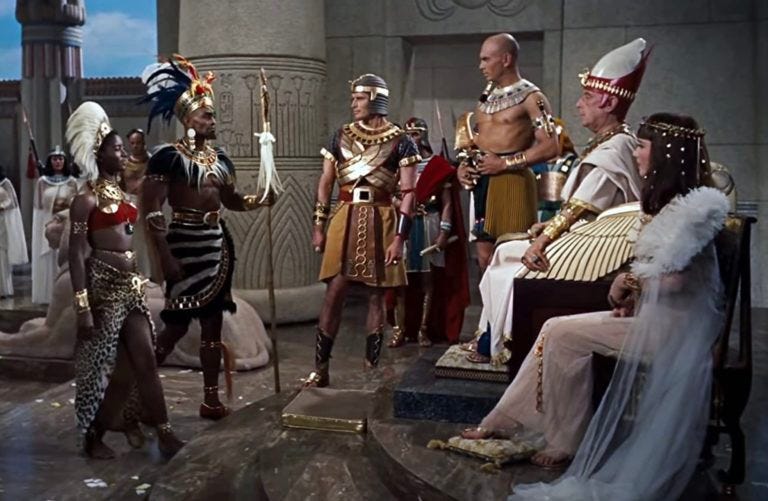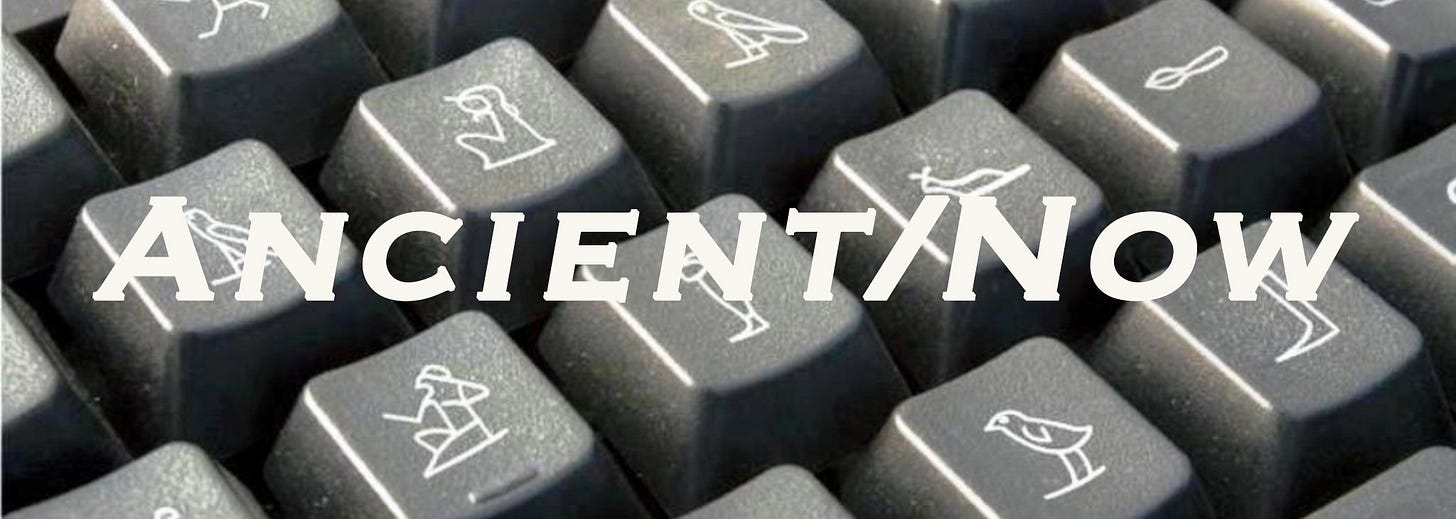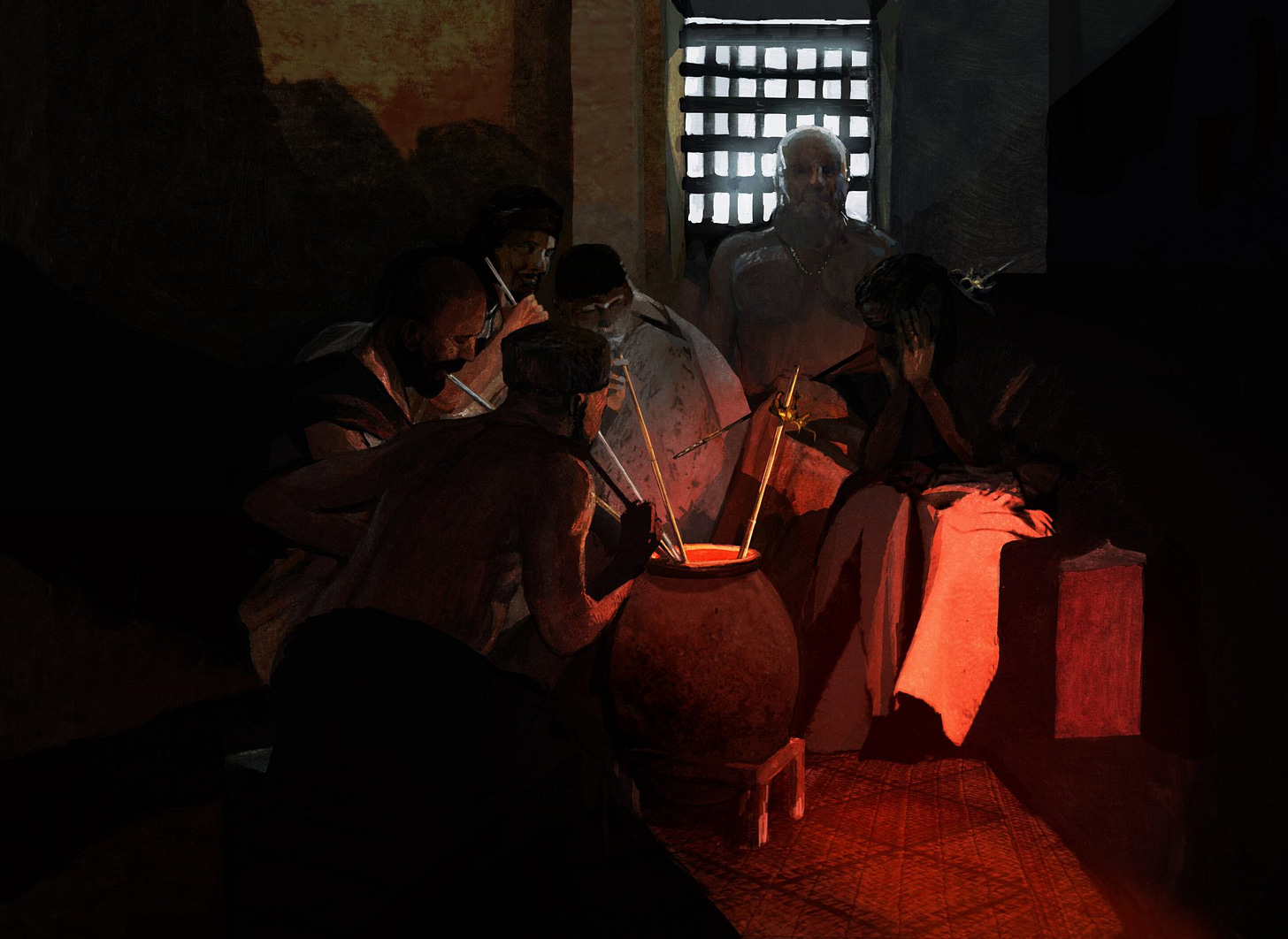Ancient/Now - February 25th
Ancient journeys in the Sinai, portraying ancient Egyptians in film and tv, the oldest drinking straws ever discovered, and more
Sinai and the journeys of Khety

Many think of Sinai as a place to find God. The Egyptians revered divinity in these mountains too, and those gods gave them copper and turquoise and carnelian. An 11th Dynasty (c. 2150-1990 BCE) “seal bearer” and “overseer of quarries” named Khety was a most well-traveled ancient Egyptian who left us a record of his travels in the Sinai. His autobiography, written on the walls of his tomb, provides linguistic clues to Semitic cultures’ connections to the Sinai that predate Moses by centuries. In this article Egyptologist Julien Cooper (Macquarie University and United International College-Beijing Normal University, Zhuhai) makes the case that one region in which Khety traveled, one that he called Ṯnht, may well have been the Biblical Sinai:
While it is difficult to link two place names separated by more than 700 years, the phonetic and geographic similarities between Ṯnht and Sînay would be amazingly coincidental. If Khety’s Ṯnht is the early form of “Sinai”, then this suggestion supports the orthodoxy (to excuse a pun) of the early Christians who located biblical “Mount Sinai” in the southern parts of the Sinai Peninsula, be it Gebel Musa or any other nearby peak like Gebel Serbal or Gebel Katerina. It is worth recalling that place names are stubborn and tenacious elements in language that can survive for a long time with little change. Many other Semitic place names like Ashqelon or Pella are similarly recorded in Egyptian documents of the Middle Kingdom and survive in a similar phonetic form to the present day, lasting for over 4,000 years. Simply put, when Khety journeyed to the mining country, well before Moses trod its mountains, local people already called it something close to Sinai.
It is unlikely that archeologists and scholars will ever be able to definitively identify the precise location of the Mount Sinai of the Biblical story of Moses, but what is certain is that they will continue to uncover the history and connections of this region to the cultural traditions of the people that have traveled its wilderness and found God there. Cultural memory has a way of never letting go of sacred places.
The controversy of the portrayal of ancient Egyptians in film and tv

In this short but pithy look at the portrayal of ancient Egyptians in film and TV, Forbes entertainment writer Josh Wilson provides a look at the Western colonial origins of Egyptology and how it defined Western culture’s relationship to Egypt as something White. In particular he notes the way in which European and American scholars separated Egypt from the rest of Africa in popular Western culture, to the point that fictional accounts almost entirely excluded people of color. Wilson writes,
The media and entertainment industry has had a labeled responsibility to inform audiences, and we must ask ourselves, are we doing enough to debunk the horrifying nuances leftover from colonialism with the whitewashing of ancient Egypt being a primary example.
As consumers of media and entertainment, we should consider what kind of stories we are boosting in profit or popularity when we buy a movie ticket or Netflix and chill.
A Met museum “guard’s-eye memoir”
Museum guards are often overlooked by visitors as they wander the galleries and most visitors are probably unaware that it may be that they are being observed with as much interest as the art. Patrick Bringley, a former guard at the Metropolitan Museum of Art, has written a “guard’s-eye memoir” of his time at the museum called All the Beauty in the World. Although the job requires standing for eight to twelve hour shifts and a special allowance to replace worn-out socks, the perks include being surrounded by beauty, history, and art—and even a special discount on hot dogs from Fifth Avenue vendors. For Bringley it was a job that offered ample time to observe and learn about both art and humanity.
“Say a person is a one-in-a-million personality. That means we’re getting seven of those a year, at least,” Bringley said. “One of the first things someone told me is, ‘You get bored of the art, you watch the people. You get bored of the people, you watch the art.’ ”
The idea of standing (or leaning) in a museum gallery for hours on end might sound like an interminable task to some people, but for guards like Bringley it served as an opportunity to “commune with things that felt fundamental” and do something “straightforward and honest and useful.” Guards are important custodians of our museum spaces, protecting things from rambunctious and careless children and adults alike.
If you’re gonna party like the early Bronze Age, don’t forget your drinking straw
Recently eight “scepters” from a richly furnished prehistoric mound (or “kurgen”) in the northern Caucasus at a site near Maikop (southern Russia) have been given a second look and have now been identified as drinking straws, so says a study published by Antiquity. When the early Bronze Age burial was discovered in the late nineteenth century, archaeologists measured each tube and found them all to be over a meter long, made of silver or gold and embellished with decorative figures of bulls. Initial interpretations suggested they might have been scepters or poles used for supporting a tent or canopy, but not so fast because,
Re-examination of these objects…suggests they were used as tubes for the communal drinking of beer, with integral filters to remove impurities. If correct, these objects represent the earliest material evidence of drinking through long tubes—a practice that became common during feasts in the third and second millennia BC in the ancient Near East.
This revised interpretation is strengthened by the fact that a large pottery vessel (big enough to hold seven pints of beer for each of the eight drinkers) was also discovered in the Maikop kurgen along with the (very fancy!) drinking straws.
And “with four bulls on straws in the jar at once…it would look like a procession of little bulls going around in a circle,” pointed out Mara Horowitz, an assistant professor of archeology at Purchase College in New York, speaking to NBC. “That’s really kind of adorable.”
While these eight straws are among the oldest drinking straws ever discovered, we have numerous artistic representations of people using drinking straws from Egypt and especially the ancient Near East. (For a few examples check out these decidedly NSFW ancient depictions of people using drinking straws.) The next time you and your friends are gathered around one of those cocktail buckets or margaritas as big as your head or even holding your disposable red Solo cup, think of eight Bronze Age revelers with their gold and silver straws crowded around a massive drinking vessel full of beer and know that you’re a part of an enduring ancient tradition.
Hitpoints & History digital conference will feature Kara as a keynote speaker
Kara’s keynote lecture for the Hitpoints & History digital conference on Saturday, March 4, 2023 will feature a look at how Cleopatra, one of the most infamous women to rule the ancient world, is portrayed in the popular video game Assassin’s Creed. The historical Cleopatra used her sexuality—and her money—to build alliances with warlords of the Roman Empire. Ancient Roman propaganda aggrandized her ultimate failure and death, painting her as a selfish woman who lived a life of luxury and seduced powerful men, ultimately abandoning her people by committing suicide. This Roman portrait of Cleopatra endures today in popular culture, including in video games like Assassin’s Creed. But, as you can imagine, Kara has something to say about all that historical misogyny….
About Hitpoints & History:
Play your way through the ancient world at Hitpoints & History, a virtual archaeogaming conference connecting academics, professionals, and gamers. Join us March 4th and 5th as we explore the open world of archaeogaming through livestreams, workshops, and collaborative gaming events. Presenters include Kara Cooney, Andrew Reinhard, Betty Robertson, and more! To find out more, buy tickets, or submit a presentation proposal, head over to hitpointscon.com.









